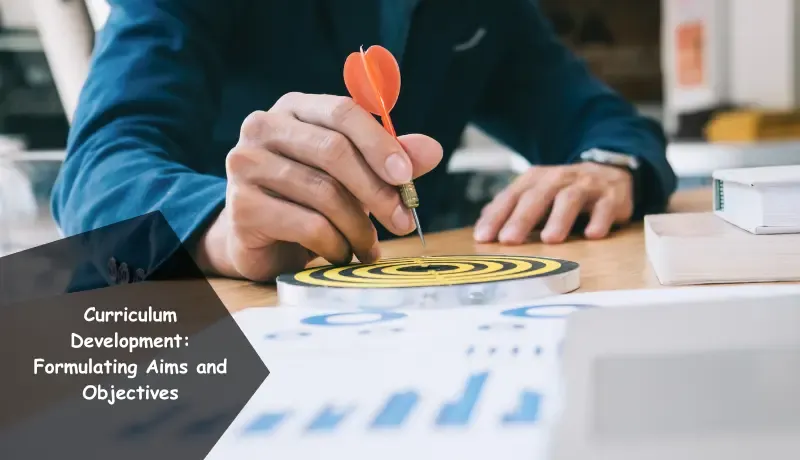Discover the key to effective curriculum development as we delve into the process of formulating aims and objectives. This comprehensive article explores the significance of setting clear educational goals, highlights practical strategies for aligning objectives with learner needs, and provides valuable insights into optimizing curriculum development.
Curriculum Development: Formulating Aims and Objectives
Welcome, dear reader, to a fascinating journey of curriculum development! In this article, we will unravel the intricacies of formulating aims and objectives, the backbone of any successful educational program. By understanding the importance of clear goals and aligning them with learner needs, educators and curriculum designers can craft dynamic and impactful learning experiences. So, fasten your seatbelts and get ready to dive deep into the world of curriculum development, where dreams and aspirations merge with pedagogical expertise!
The Significance of Aims and Objectives
Formulating clear aims and objectives is like charting a course before embarking on a grand voyage. They provide a sense of direction, purpose, and vision, guiding educators and learners alike toward educational success. Let's explore why aims and objectives are crucial in curriculum development:
1. Setting the destination:
Aims to establish the overarching goals of an educational program, reflecting the desired outcomes and long-term vision. Objectives, on the other hand, break down these aims into specific, measurable, achievable, relevant, and time-bound (SMART) targets that help pave the way to success.
2. Enabling focused learning:
Aims and objectives shape the learning experience by defining what students should know, understand, and be able to do upon completion of the curriculum. They ensure that instructional efforts remain focused, relevant, and aligned with the desired outcomes.
3. Informing assessment and evaluation:
Clear aims and objectives provide the foundation for effective assessment and evaluation strategies. By defining the expected learning outcomes, educators can design appropriate assessments to measure student progress and evaluate the effectiveness of the curriculum.
4. Enhancing learner motivation:
Well-crafted aims and objectives can inspire and motivate learners by highlighting the relevance and significance of their educational journey. When students understand the purpose and value of their studies, they are more likely to engage actively and persistently in their learning endeavors.
Strategies for Formulating Aims and Objectives
Now that we comprehend the importance of aims and objectives, let's explore practical strategies for formulating them effectively. By following these guidelines, educators and curriculum designers can develop clear, concise, and purposeful educational goals:
1. Analyze the needs of learners:
Begin by understanding the characteristics, interests, and learning preferences of the target audience. Conduct surveys, interviews, and needs assessments to gather valuable insights and ensure that the aims and objectives are tailored to meet their specific requirements.
2. Collaborate with stakeholders:
Involve all relevant stakeholders, such as teachers, administrators, parents, and community members, in the curriculum development process. Their input can provide diverse perspectives and contribute to the formulation of aims and objectives that address the broader educational context.
3. Align with educational standards:
Familiarize yourself with local, national, or international educational standards and frameworks. Ensure that your aims and objectives are aligned with these standards to promote consistency and facilitate the transfer of credits between educational institutions.
4. Follow the ABCD model:
Adopt the ABCD model (Audience, Behavior, Condition, and Degree) to structure your objectives effectively. Start by identifying the target audience, specifying the desired behavior or outcome, defining the conditions under which the behavior is expected, and determining the degree or level of mastery required.
5. Keep it specific and measurable:
Aim for clarity and precision in your aims and objectives. Use action verbs to describe observable and measurable behaviors, avoiding vague or subjective language. This ensures that objectives can be assessed and progress can be tracked effectively.
6. Consider the cognitive domain:
Take into account the cognitive domain, as proposed by educational psychologist Benjamin Bloom. Consider the hierarchical levels of cognitive complexity, such as knowledge, comprehension, application, analysis, synthesis, and evaluation, when formulating objectives to promote higher-order thinking skills.
7. Balance breadth and depth:
Strive for a balanced curriculum that encompasses both breadth and depth of knowledge. Develop aims and objectives that provide comprehensive coverage of essential content while allowing for in-depth exploration of key concepts.
8. Promote relevance and authenticity:
Engage learners by designing aims and objectives that relate to their lives and real-world contexts. Link learning to practical applications and emphasize the acquisition of skills that students can apply beyond the classroom.
Frequently Asked Questions (FAQs)
1. Why is it important to align aims and objectives with learner needs?
Aligning aims and objectives with learner needs ensures that educational goals are relevant, meaningful, and tailored to the specific requirements of the students. It enhances learner motivation, engagement, and overall learning outcomes.
2. Can aims and objectives change during the curriculum development process?
Yes, aims and objectives can evolve and adapt based on ongoing evaluation, feedback, and changing educational contexts. Curriculum development is a dynamic process and aims and objectives should be flexible enough to accommodate new insights and emerging needs.
3. How can technology support the formulation of aims and objectives?
Technology can facilitate data collection, analysis, and collaboration, allowing educators to gather information about learner needs more efficiently. It also offers innovative tools and platforms for designing interactive and personalized learning experiences that align with the formulated aims and objectives.
4. What role do aims and objectives play in instructional design?
Aims and objectives provide a solid foundation for instructional design. They guide the selection of appropriate instructional strategies, learning resources, and assessment methods that align with the desired learning outcomes.
Conclusion
Formulating clear aims and objectives lies at the heart of effective curriculum development. By setting educational goals, aligning them with learner needs, and employing practical strategies, educators and curriculum designers can create impactful learning experiences. The journey of curriculum development begins here, with the art of formulating aims and objectives, where dreams of educational excellence take shape and transform lives. So, let's embark on this exciting adventure together and unlock the true potential of our learners!
